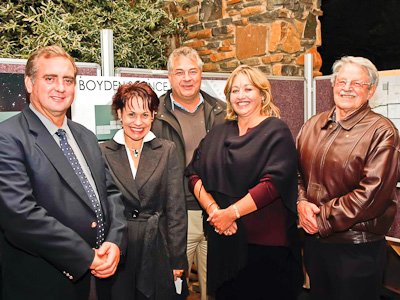|

|
At the celebration of the 120th year of existence of the UFS's Boyden Observatory are, from the left: Prof. Herman van Schalkwyk, Dean: Faculty of Natural and Agricultural Sciences at the UFS, Prof. Driekie Hay, Vice-Rector: Academic Planning at the UFS, Mr Ian Heyns from AngloGold Ashanti and his wife, Cheryl, and Prof. François Retief, former rector of the UFS and patron of the Friends of Boyden.
Photo: Hannes Pieterse |
The Boyden Observatory, one of the oldest observatories in the Southern Hemisphere and a prominent beacon in Bloemfontein, recently celebrated its 120th year of existence.
This milestone was celebrated by staff, students, other dignitaries of the University of the Free State (UFS) and special guests at the observatory last week.
“The observatory provides the Free State with a unique scientific, educational and tourist facility. No other city in South Africa, and few in the world, has a public observatory with telescopes the size and quality of those at Boyden,” said Prof. Herman van Schalkwyk, Dean of the Faculty of Natural and Agricultural Sciences at the UFS.
The observatory, boasting the third-largest optical telescope in South Africa, has a long and illustrious history. It was established on a temporary site on Mount Harvard near the small town of Chosica, Peru in 1889. Later it was moved to Arequipa in Peru where important astronomical observations were made from 1891 to 1926. “However, due to unstable weather patterns and observing conditions, it was decided to move the Boyden Station to another site somewhere else in the Southern Hemisphere, maybe South Africa,” said Prof. Van Schalkwyk.
South Africa's excellent climatic conditions were fairly well known and in 1927 the instruments were shipped and the Boyden Station was set up next to Maselspoort near Bloemfontein. Observations began in September 1927 and in 1933 the new site was officially completed, including the 60 inch (1.5 m) telescope, which was then the largest optical telescope in the Southern Hemisphere. This telescope was recently refurbished to a modern research instrument.
The observatory has various other telescopes and one of them, the 13" refractor telescope, which was sent to Arequipa in 1891 and later to Bloemfontein, is still in an excellent condition. Another important telescope is the Watcher Robotic Telescope of the University College Dublin, which conducts many successful observations of gamma ray bursts.
“In the first few decades of the twentieth century, the Boyden Observatory contributed considerably to our understanding of the secrets of the universe at large. The period luminosity relationship of the Cepheid variable stars was, for example, discovered from observations obtained at Boyden. This relationship is one of the cornerstones of modern astrophysics. It is currently used to make estimates of the size and age of the universe from observations of the Hubble Space Telescope,” said Prof. Van Schalkwyk.
“The Boyden Observatory contributed to the university’s astrophysics research group being able to produce the first M.Sc. degrees associated with the National Space Science Programme (NASSAP) in the country and the Boyden Science Centre plays an important role in science and technology awareness of learners, teachers and the general public,” said Prof. Van Schalkwyk.
The Boyden Science Centre has also formed strong relationships with various institutions, including the South African Agency for the Advancement of Science and Technology (SAASTA) and the Department of Science and Technology. The centre has already conducted many different projects for the Department of Science and Technology, including National Science Week projects, as well as National Astronomy Month projects. It also serves as one of the hosts of SAASTA’s annual Astronomy Quiz.
Media Release:
Lacea Loader
Assistant Director: Media Liaison
Tel: 051 401 2584
Cell: 083 645 2454
E-mail: loaderl.stg@ufs.ac.za
13 May 2009